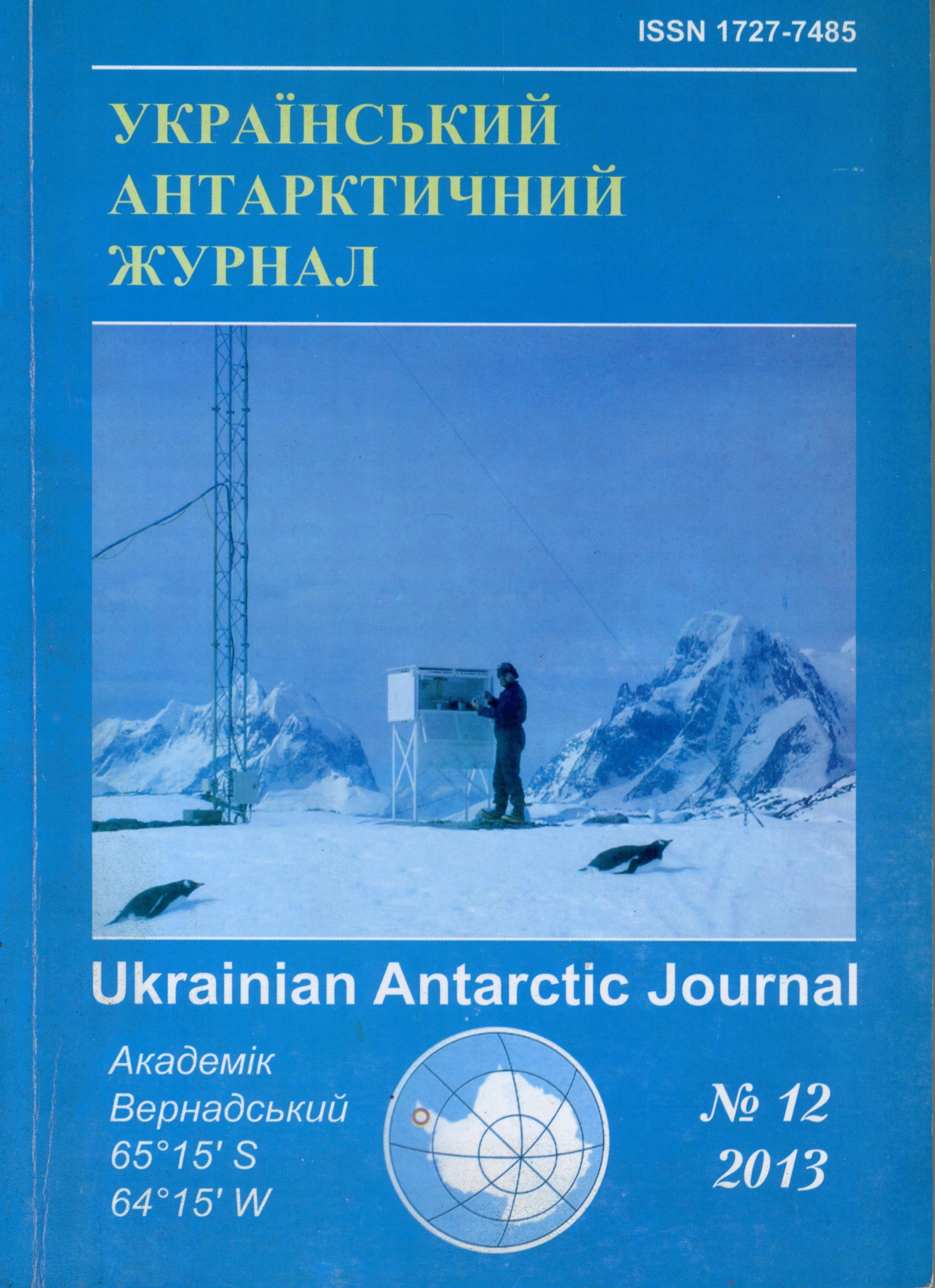- sea-ice,
- air and sea surface temperature,
- atmospheric circulation,
- circulation index,
- El Nіño index
Abstract
The long-term change in the sea ice in the Antarctic shows growing in most months of the year, with a peak in March-May - a transition season with the formation of the seasonal ice. During the summer season a long-term retreat in the sea ice is found in water areas west of the Antarctic Peninsula on the background of significant inter-annual variations. Anomaly in the sea-ice cover is accompanied by an anomaly in the air and sea surface temperature (SST) fields and is caused by a certain type of atmospheric circulation. Advance of sea-ice during the summer seasons is observed against negative air temperature anomaly and the southern component of the wind. The study allows us to find the potential predictability of seasonal anomalies in the sea-ice. As predictors we used El Nіño index, indexes of regional atmospheric circulation, air temperature and SST measured at Vernadsky Station. To assess the development of the sea-ice anomalies it is necessary to identify the commencement of the spring retreat of the ice associated with the transition of the SST the freezing point. The consistency of the sea ice anomalies is important prognostic indicator in the seasonal time scale. Sea ice anomaly during the summer season 2011-2012 is analyzed in detail, when the planned shift of seasonal teams at Vernadsky Station was interrupted for the first time in many years. Type of atmospheric circulation responsible for the anomalous sea-ice is shown.
References
- Atlas okeanov. Antarktika [Atlas of oceans. Antarctica]. (2005). GUNO MO RF. St. Petersburg.
- Bulgakov, M.P., Artamonov, Yu.V., Grishhenko, V.F. et al. (2000). Osobennosti ledovy`x uslovij v rajone Antarkticheskogo poluostrova i morya Skotiya osen`yu 1998 g. po danny`m Vtoroj ukrainskoj antarkticheskoj e`kspedicii [Specifics of ice conditions in the region of the Antarctic Peninsula and Scotia Sea in late 1998 by the data of the Second Ukrainian Antarctic Expedition]. Dokl. NAN Ukrainy`, 2, 107–110.
- Grishhenko, V.F., & Timofeev V.E. (2005). Reakcii komponentov glyaciosfery` na izmeneniya klimata v rajone Antarkticheskogo poluostrova [Reactions of the components of the glaciosphere on the climate changes in the Antarctic Peninsula region]. Ukrainian Antarctic Journal, 3, 99–107.
- Gruza, G.V., Ran`kova, E.Ya., & Rocheva, E.V. (2007). Krupnomasshtabny`e kolebaniya atmosfernoj cirkulyacii v Yuzhnom polusharii i ix vliyanie na izmenenie klimata v nekotory`x regionax planety` v XX stoletii [Large-scale oscillations of atmospheric circulation in the Southern Hemisphere and their effect on the climate change in some regions of the planet in XX century]. Meteorologiya i gidrologiya, 7, 5–17.
- Kotlyakov, V.M. (Ed.). (1992). Rezhim i e`volyuciya polyarny`x lednikovy`x pokrovov [Regime and evolution of the polar ice sheet covers]. S.Petersburg, Gidrometeoizdat.
- Martazinova, V.F., Timofeev, V.E., & Ivanova, E.K. (2008). Costoyanie cirkulyacii nizhnej troposfery` Yuzhnoj polyarnoj oblasti v period sovremennogo potepleniya [The state of the circulation of the lower troposphere in the Southern Polar region furing the current warming]. Ukrainian Antarctic Journal, 6-7, 175–183.
- Martazinova, V.F., Timofeev, V.E., & Ivanova, E.K. (2010). Atmosfernaya cirkulyaciya Yuzhnoj polyarnoj oblasti i klimat Antarkticheskogo poluostrova [Atmospheric circulationof the Southern Polar region and the climate of the Antarctic Peninsula]. Kyiv.
- Klimaticheskij rezhim Arktiki na rubezhe XX i XX1 vv. [Climatic regime of the Arctic at the border of XX and XXI centuries] (1991). S.-Petersburg, Gidrometeoizdat.
- Maslennikov, V.V. (2003). Klimaticheskie kolebaniya i morskaya e`kosistema Antarktiki [Climatic oscillations and the marine ecosystem of Antarctica]. Moscow, Izd. VNIRO.
- Peklo, A.M. (2007). Pticy Argentinskix ostrovov i ostrova Piterman [Birds of the Argentine Islands and the Petermann Island]. Krivoj Rog, Mineral.
- Popov, V.I., & Skry`pnik, V.V. (2003). Antarkticheskij zhurnal, 1, 79–84.
- Carleton, A.M. (1989). Antarctic sea–ice relationships with indices of the atmospheric circulation of the Southern Hemisphere. Climate Dynamics, 3, 207–220.
- Cavalieri, D.J., Parkinson, C.L., & Vinnikov, K.Y. (2003). 30-year satellite record reveals contrasting Arctic and Antarctic decadal sea ice variability. Geophysical Research Letters.
- Gillett, N.P., Kell, T.D., & Jones, P.D. (2006). Regional climate impacts of the Southern Annular Mode. Geophysical research Letters, 34, L23704.
- Harangozo, S.A. (1997). Atmospheric meridional circulation impacts on contrasting winter sea ice extent in two years in the Pacific sector of the Southern Ocean. Tellus, 49(3), 388–400.
- Harangozo, S.A. (2000). A search for ENSO teleconnections in the west Antarctic Peninsula climate in Austral winter. International Journal of Climatology, 20, 663–679.
- Heap, J.A. (1965). Antarctic pack ice. In T. Hatherton (Ed.), Antarctica. Praeger. pp. 187–196.
- Hinzmann, L.D. et al. (2005). Evidence and implications of recent climate change in Northern Alaska and other Arctic regions. Climatic Change, 72, 251–298.
- Holland, P.R., Kwok, R. (2012). Wind-driven trends in Antarctic sea-ice drift. Nature Geoscience, 5, 872–875.
- Kawaguchi, S., Nicol, S., Taki, K., & Naganobu, M. (2006). Fishing ground selection in the Antarctic krill fishery: trends in patterns across years, seasons and nations. Commission for the Conservation of Antarctic Marine Living Resources Science, 13, 117–141.
- King, J.C., & Harangozo, S.A. (1998). Climate change in the western Antarctic Peninsula since 1945: observations and possible causes. Annals of Glaciology, 27, 571–575.
- Kwok, R., & Comiso, J.C. (2002). Spatial patterns of variability in Antarctic surface temperature: connections to the Southern Hemisphere Annular Mode and the Southern Oscillation. Geophysical Research Letters, 29, 50-1–50-4.
- Van Loon, H., & Shea, D.J. (1985). The southern oscillation part IV: the precursors south of 15 °S to the extremes of the oscillation. Мonthly Weather Review, 113, 2063–2074.

